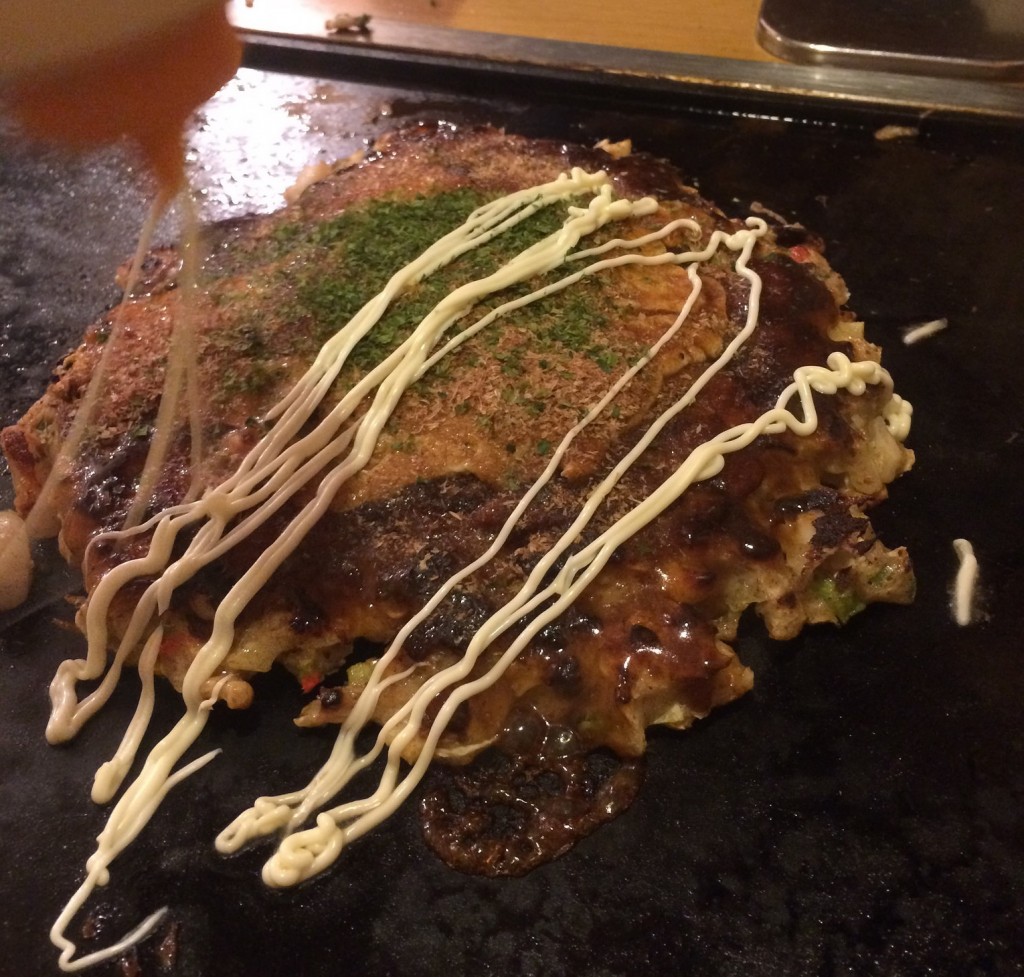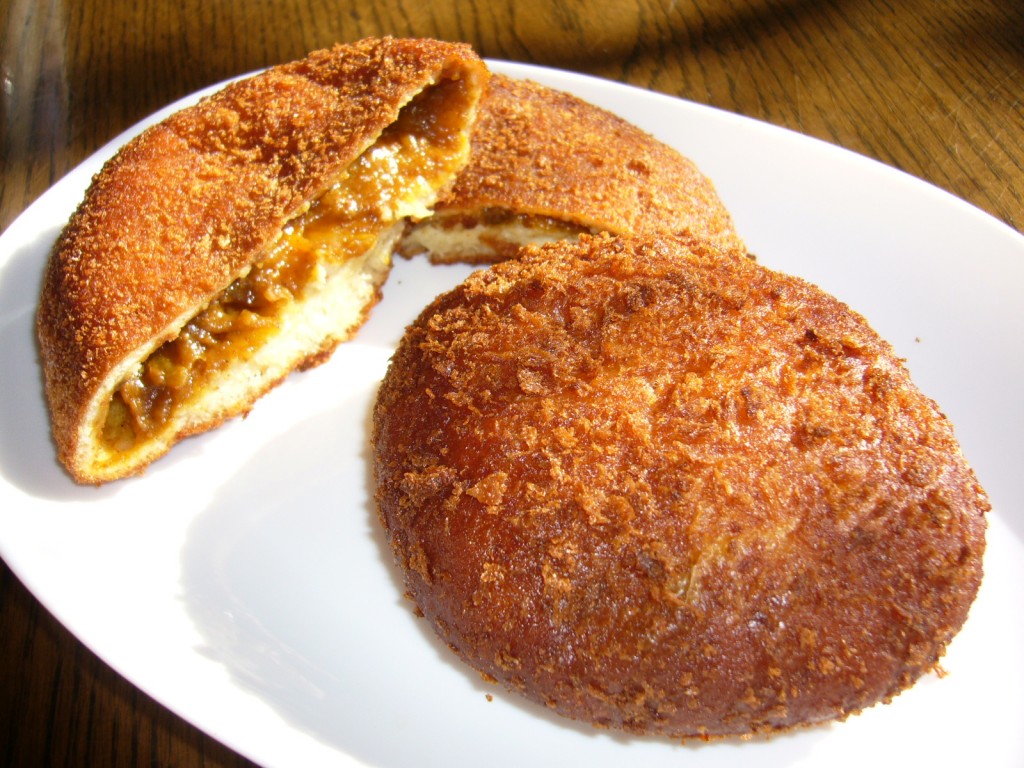Don’t Leave Japan Without Trying These Foods

Madeleine is a Sydney-based freelancer who pretends she can speak…
When it comes to travelling to new and exotic destinations, it’s often not about how many days you have left – it’s about how many meals and snacks you can fit in before you go. Japan embraces the weird and the wonderful better than most, and this is evident in their food culture. So throw caution to the wind, and get your mouth around all that Japan has to offer.
RELATED: 5 THINGS I NEVER THOUGHT I’D EAT UNTIL I ATE THEM IN TOKYO
Okonomiyaki
My mother always told me not to play with my food, but with okonomiyaki it’s half the fun. This has to be one of the best hands-on dining experiences around. Having sampled okonomiyaki in each town, you get to understand the subtle local differences and twists on this popular dish that literally translates to ‘what you like grilled’.
One of the best okonomiyaki joints going around is the Sakura Tei in the backstreets of Harajuku. The atmosphere is great, the beer is cold, and there’s artworks scrawled on every available wall space. They’re open 365 days a year and offer some impressive all-you-can-eat options to while away an evening after pounding the pavement all day. You sit at a table with a built-in barbecue plate (great in winter), and order any combination of flavours from the extensive menu. Choices include the Sakurayaki Original (pork, shrimp, squid, welsh onions, shiitake mushrooms, pork ribs, egg) or the more western Fried Cheese Melt (three cheeses). They’ll bring you the bowl of raw ingredients and the rest is up to you.

The base is like a shredded cabbage pancake batter, with your chosen ingredients – strips of meat, cheese, veggies. From here you put in some elbow grease and stir it up good before pouring onto the hot plate in front of you. Cook until golden, flip and repeat. Then smother with the chef’s special sauce and enjoy, before going back for more.
Food halls
Food courts remind me of year nine dates, killing time during university and bad food decisions. But in Japan they’re like a theme park for your senses and wholly encouraged. Almost without fail you’ll find them in the basement level of department stores, sometimes spread out over two-mouthwatering-floors as they tempt you with all things delicious.

The Japanese have a way of doing everything with pride, and nowhere is this better reflected than food halls. Their fresh produce is packaged and displayed beautifully; meat counters are an art form, and fish comes in all forms from fresh to dried.
Perusing the prepared foods section is an activity in itself. Every craving can be sated in these magical halls. From bento boxes and yakitori to sashimi and sandwiches. The baked treats section will have you running from your no-gluten diet faster than you can say “I’ll have a Danish in every flavour, arigatō”, and the intricate desserts and chocolate are to all be sampled.

Throw away all previous misconceptions about food courts, throw away any attempt at a diet, and just take in everything that these wonderful food halls have to offer.
Oyster Curry Bread

If a donut, an oyster and Keens Curry Powder had a love child it would result in the tastes-better-in-your-mouth-than-it-sounds-on-paper oyster curry bread that can be found on the picturesque island of Miyajima.
Let’s break it down. The mouth feels are a rollercoaster of texture; the crispy fried savoury donut on the outside gives way to tasty oysters cooked in a lightly curried sauce on the inside. Served warm, these balls of fried goodness go so well with an ale in hand (try the local Miyajima Brewery brews).
Oysters are a specialty on this island, and if you hike the holy mountain Mount Misen (approximately 500 metres above sea level) you’ll see why. At the top you’re treated to views over the surrounding bays, many of which are dotted by oyster farms. You’re assured that the oysters are as fresh as the Shinkansens (bullet trains) are fast.
Going for just 320 yen ($3.30AUD) each, buy them in bulk early to make sure they don’t sell out. For the best oyster curry bread on the island, find the stall next to the Sakuraya Hotel.
Ramen
It’s almost an insult to talk about ramen in only a few hundred words, but without it this list would be nothing. In a country where the unofficial national dish has museums to celebrate it, you know the Japanese mean business when it comes to their noddle soup. In fact, it’s such serious business that they’ve created vending machines to help put the ramen in your mouth faster and more efficiently.

Firstly there are no lost-in-translations when ordering – what you pick is what you get. Staff don’t have to deal with money or change – making the transaction seamless and clean. And for those whose Japanese is limited only to the niceties or necessities, it allows you to window shop for your dinner via the many ramen images assigned to each button. Every ramen restaurant has their house specialties on offer, but you can add on extras like a boiled egg or a double serve of pork slices for example. With four classes of ramen base plus noodle selection, protein choice, and add-ons there must be millions of ramen permutations, so you appreciate the ample choice.

While you’re there I strongly suggest opting in for some gyoza to start, and beer can be ordered from the machine too. All that left for you to do is hand your ticket to one of the staff and wait for your meal to be promptly delivered to your seat. One of the best parts is that there are no rules when eating ramen, so don’t be afraid to slurp.
Canned Walrus
Stepping into one of the 40 Mr Kanso bars across Japan is like stepping into a survivalist’s dream world – it’s nothing but non-perishables from floor to ceiling. You’ll probably need a local tipple in hand just to deal with the wonder of the immaculately presented canned goods on all the shelves, not unlike a gourmet grocer.

The array of food is impressive from crisps in a can, to olives, to tinned fish. Then things get whacky. There’s a rice and bean mix, a rolled egg omelette, horse meat and also whale if you dare. We opted for a local version of Pringles (safe bet), and we picked up a can that proudly displayed a walrus, because when in Rome Japan.
We had read that you hand your can to the barman and he does what’s necessary to prep your meal. I had images of perhaps a light zap in the microwave, maybe a quick heat up on the stove. But in reality it was far more efficient and a lot less appetising than that. Mr Kanso (not his real name) pulled the top off the can of walrus, put the can on a plate, and garnished it with a side of chopsticks. We ordered another whisky (devil’s courage) and did whatever the slow motion, hesitant version of tucking in is. Walrus in a can looks like chunks of eggplant layered in fat. As for the taste – and remember that this is served cold – it is rich, musky, and slimy.
Go for the experience, stay for the whisky. This bar won’t be for everyone, but it’s certainly a once in a lifetime opportunity.
(Lead image: Tania Ho/Flickr)
Madeleine is a Sydney-based freelancer who pretends she can speak Spanish far more fluently than she actually can. With 35+ countries under her belt, she's always looking to add more. You can follow her travels near and far at @madeleinegasparinatos.








